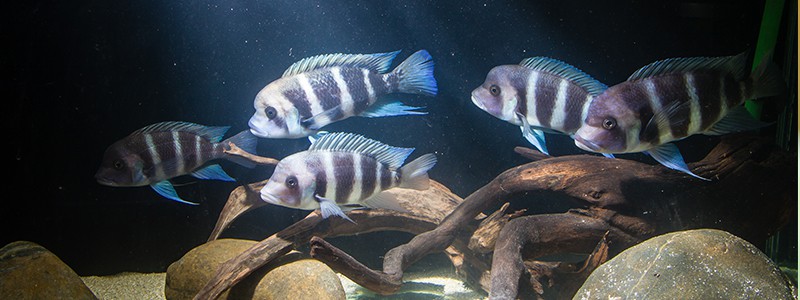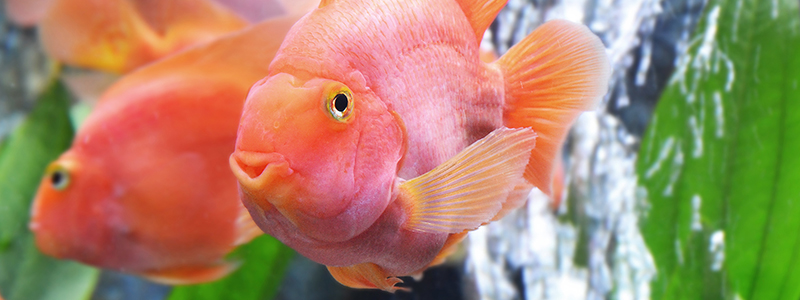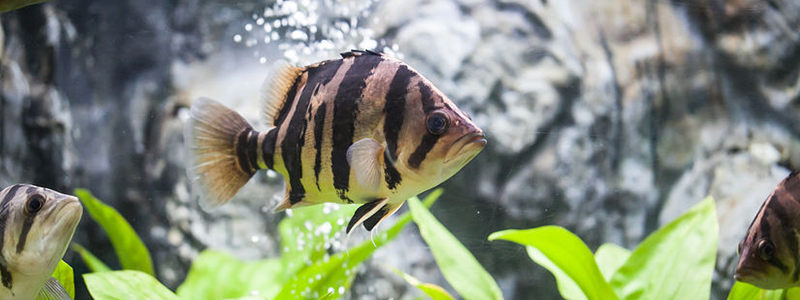Quick Stats
- Family: Cichlidae
- Scientific Name: Cyphotilapia frontosa
- Care level: Moderate
- Temperament: Semi-aggressive
- Diet: Carnivorous
- Water conditions: Freshwater, 23.3 – 26.1 degrees Celsius (74 – 79F), 9 pH, Soft/Alkaline
- Max Size: 35 centimeters (14 inches)
- Minimum tank size (as an adult): 265 Liters (70 gallons)
Brief Overview: Frontosa Fish Care
Frontosas are cichlids highly prized in the fish-keeping community for their pronounced coloration and large size. The Frontosa is characterized by a white or blue body with six or seven bold, black bands; some individuals even sport gold accents on their dorsal fins. Also known as the Humphead Cichlid, both male and female Frontosas develop a large cranial hump as they mature. Males eventually grow larger than females and have longer fins, but this fish can be difficult to sex even upon maturity.
Frontosas are found in Lake Tanganyika in Africa, where they are found in many locations but usually inhabit waters between 11 and 70 meters (35 and 170 feet) deep. Unlike other cichlids who inhabit caves, Frontosas live in large groups along the lake floor. These fish are difficult to collect in the wild, which made them rare and expensive to obtain in the past. Now that captive breeding has become successful, Frontosas are more readily available.
There are several different color variants of this species, and recently one color variant was discovered to be its own species. The Southern Frontosa or Blue Frontosa (Cyphotilapia gibberosa) was designated a separate species in 2003. Other color variants of this species are still under investigation to ascertain whether they are a separate species.
This fish is prized for its unique coloration, but what has cemented its status as a favorite among cichlid keepers is its personality. Both wild-caught and aquarium-raised Frontosas are outgoing and amicable, willing to eat right out of your hand. Though they are not very active or aggressive in nature, you can usually expect an enthusiastic greeting from your Frontosa.
Frontosa Fish Lifespan

How Long Do Frontosa Live For?
Frontosas have an average lifespan of 12-15 years in an aquarium but with excellent care and conditions can live 25 years or more. Many attribute this long life to their rather sedentary nature.
How fast/slow should you expect your Frontosa to grow?
Frontosas grow slowly, taking as many as 3 to 4 years to reach sexual maturity.
What’s a Frontosa’s max size?
The maximum size of a Frontosa in the wild is 40 centimeters (16 inches) but in an aquarium, females reach around 25 centimeters (10 inches) and males usually reach at least 30 centimeters (12 inches).
Different types of Frontosa
There are several color variations among Frontosa and most of these are defined by geographic region; Frontosa are fairly sedentary and do not travel far.
Burundi Six-Stripe Frontosa: This variation has a large hump and nice banding. They have blue on their bodies and six bands instead of seven.
Zaire Blue Frontosa: named for the former name of the Congo Republic, this variation has the bluest body of them all: some are such a deep blue they appear purple in color. The band on the head runs between the eyes and down to the gills. Some are a solid blue and some have blue dots on their bands.
Tanzanian Six-Stripe Frontosa: This variation looks very similar to the Burundi Six-Stripe, but if the two variants are crossed the offspring produced have slanted bands.
Tanzanian Seven-Stripe Frontosa: Also known as the Frontosa Kigoma, this variation is highly prized. This fish is identifiable by a seventh band that appears more like a mask on its face, a large blue hump on its head, and gold accents on the dorsal fin.
Kipili Frontosa: This variety is rarely exported as it has a less flashy appearance: though they sport blue coloration, it is not nearly as attractive as other varieties.
Zambian Blue Frontosa: Also known as the Blue Face Frontosa, the band on the head of this fish fades just above the eyes.
Samazi Frontosa: This fish exhibits sexual dimorphism, with the males sporting a nice blue color and the females showing very little to no blue coloration. This variation is also notoriously difficult to breed.
Kavalla Frontosa: This extremely rare variety has six bands, blue accents, and a yellow dorsal fin with a multi-colored sheen. This fish is known to turn dark when its mood changes.
Frontosa Fish Diet & Feeding
Frontosa are carnivorous, feeding primarily on small fish.
What do Frontosa Fish eat in the wild?
Frontosas are native to Lake Tanganyika, where they inhabit the lake floor in large groups called colonies. This fish typically feeds during dusk, when large schools of Cyphrichromis species descend to the bottom of the lake. Frontosas will feed on almost any other live food they can catch including snails and mollusks.
What foods are recommended for Frontosa Fish?
In an aquarium setting, Frontosas are slow feeders. They will eat a varied diet including pellets, feeder fish, worms, and crustaceans like shrimp and krill. Take caution feeding your Frontosa live food as these can introduce bacteria and parasites into your tank.
Frontosa Fish Feeding habits
Plan to feed your Frontosa anywhere from 2 to 5 meals a day. Spreading their diet out over more meals will keep water quality higher for a longer period of time. Only feed your fish as much as they can consume in 2 to 3 minutes.
Frontosa Fish Fish Tank Setup
Like all fish, Frontosas thrive best in a tank that resembles their natural habitat and properly suits their needs.
A brief overview of natural habitat
Frontosas are indigenous to a single lake in Africa. They are commonly found in deeper waters along the coastal lake floor. Lake Tanganyika is the second largest lake in the world, so temperature and pH fluctuate very little. The lake water also has a high oxygen concentration.
Frontosas Fish Tank size
Tank size requirements for Frontosas are a minimum of 265 Liters (70 gallons) for an adult. Larger tanks offer a more stable environment, are less prone to sudden changes, and are an overall better choice for your fish. Frontosa are highly social and need to be kept in groups, so a minimum tank size for a small school of Frontosa is 470 liters (125 gallons) and an ideal size is 750 liters (200 gallons) or more.
Frontosa Fish Water Conditions
Frontosas should be kept in water conditions similar to their habitat in the wild. Water should ideally remain between 23.3 and 26.1 degrees Celsius (74 to 79 degrees Fahrenheit) but can fluctuate between 22.2 and 30 degrees Celsius (72 to 86 degrees Fahrenheit). Their native lake home is alkaline with a pH of around 9 and a very hard dGH of 12 to 14. Lake Tanganyika is oxygen-rich, so a bubbler should be in operation day and night. The most important aspect of water condition for Frontosas is that fluctuations are low and water is maintained with regular, small changes.
Frontosas also benefit from the addition of iodine for their thyroid, which regulates growth and development, to function properly. This can be accomplished by adding iodized table salt to the water in the amount of 14.3 grams per 40 liters (1 tablespoon per 11 gallons) of water.
Tank Decorations
Tanks should consist of sandy or small-sized gravel substrate; crushed coral or aragonite sand can help maintain the tank’s pH. Frontosas need both open swimming space and rock or cave formations in which to hide. Plants are not essential but neither will Frontosas damage or dig them up. Make sure all tank decorations are firmly secure and have no sharp edges, as Frontosa are typically slow swimmers but move quickly and clumsily when startled.

Frontosa Fish Tank Mates
Unlike many cichlids, Frontosas are fairly peaceful and very social by nature. Frontosas should ideally be kept in a minimum group of 1 male and 4-5 females or in larger groups of 8 to 12 fish. Males can be territorial but many show little or no signs of this behavior.
Frontosas can be kept in a tank with other non-aggressive fish 7.6 centimeters (3 inches) or larger, as small fish will be viewed as prey. More aggressive fish like other species of cichlids make poor tank mates for the less-aggressive Frontosa.
Some possible compatible tank mates for the Frontosa are:
- Plecostomus
- Bichirs
- Clown Loach
- Blue Dolphin Cichlid
- White Calvis
- Petricola
Frontosa Fish General Behavior
Frontosas are slow-moving but outgoing fish. They have been known to recognize their owners and eat directly from their hand. If startled, their clumsy reactions often see them swimming into tank decor.
How to Keep Frontosa Fish Healthy
There are no specific diseases that Frontosas are prone to, but this species is susceptible to the typical ailments that affect freshwater fish.
Common diseases to look out for
Like most aquarium fish, Frontosas are susceptible to ich, a disease caused by protozoa. Symptoms of ich include twitching, rubbing their bodies on various surfaces in the tank, and the appearance of white spots on the body and gills. They usually respond well to medication and heal quickly.
Frontosas can be affected by skin flukes and other parasites, fungal infections, and bacterial infections.
When treating an individual fish, best practice calls for removing the fish to a separate “hospital tank” devoid of plants or gravel for treatment. If a disease has affected an entire tank, it is probably best to treat the tank. Read and follow the instructions for any medication or treatment for best results. Take care, as some treatments can destroy beneficial bacteria or otherwise adversely affect water quality. The carbon in your filtration system may absorb some medications, rendering treatment ineffective, and may need to be removed.
Know the signs and treatments of common freshwater fish diseases to catch problems early and keep your Frontosas happy and healthy.
Tips on keeping Frontosa Fish in good health
Frontosas are typically easy to keep healthy as long as you monitor and maintain your water composition. Perform small water changes every week and test water quality regularly to keep ammonium and nitrite levels in check, and do not overfeed as food waste will cause these levels to spike. Frontosas are negatively affected by large or quick fluctuations in water conditions.
High-quality foods are less likely to cause organ issues and constipation than cheaper foods.
Keep in mind that parasites and bacteria can be introduced by new tank mates as well as live food, plants, and tank decorations.
Breeding Frontosas
Though some varieties are easier to breed than other, many variations have long been bred in captivity. Breeding Frontosas requires patience, as both males and females take between 3 and 4 years to sexually mature. Optimal breeding groups consist of one male and several females. The only sexual difference between males and females is males are typically larger and have a more pronounced cranial hump.
In the wild females spawn in caves but in aquariums prefer to spawn on the substrate. Breeding tanks should be 380 liters (100 gallons) or larger, with rocks and clay pot decor the male can use to establish a territory. Frontosa do not exhibit much in the way of breeding behavior. Females will deposit an average of 50 eggs in a sandy pit between rocks and the male will fertilize them. The male then defends the area while the female picks the eggs up in her mouth. This behavior is called mouth-brooding. After the eggs hatch roughly 3 days later, the female will continue to carry the fry in her mouth for 4 to 6 weeks. Fry can be fed live brine shrimp.
Interesting Facts About Frontosa Fish
- A new species of Frontosa, the Blue Frontosa, was distinguished in 2003.
- Varieties of Frontosa are still being investigated to determine if they are separate species.
Is a Frontosa Fish right for you?
As long as proper water conditions are maintained and fluctuations are kept to a minimum, keeping a Frontosa happy and healthy is relatively easy. Consider Frontosa if you have a relatively sizable tank capable of housing at least 5 of these large, brightly-colored fish. Their resplendent appearance and outgoing, friendly nature towards their human caretakers makes these fish a popular choice for aquarists.




